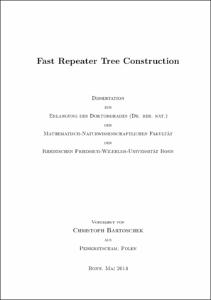Bartoschek, Christoph: Fast Repeater Tree Construction. - Bonn, 2014. - Dissertation, Rheinische Friedrich-Wilhelms-Universität Bonn.
Online-Ausgabe in bonndoc: https://nbn-resolving.org/urn:nbn:de:hbz:5n-36897
Online-Ausgabe in bonndoc: https://nbn-resolving.org/urn:nbn:de:hbz:5n-36897
@phdthesis{handle:20.500.11811/6134,
urn: https://nbn-resolving.org/urn:nbn:de:hbz:5n-36897,
author = {{Christoph Bartoschek}},
title = {Fast Repeater Tree Construction},
school = {Rheinische Friedrich-Wilhelms-Universität Bonn},
year = 2014,
month = sep,
note = {Repeaters are used during physical design of chips to improve the electrical and timing properties of interconnections. They are added along Steiner trees that connect root gates to sinks, creating repeater trees. Their construction became a crucial part of chip design. We present a new algorithm to solve the repeater tree construction problem.
We first present an extensive version of the Repeater Tree Problem. Our problem formulation encapsulates most of the constraints that have been studied so far. We also consider several aspects for the first time, for example, slew dependent required arrival times at repeater tree sinks. The employed technology, the properties of available repeaters and metal wires, the shape of the chip, the temperature, the voltages, and many other factors highly influence the results of repeater tree construction. To take all this into account, we extensively preprocess the environment to extract parameters for our algorithms.
We first present an algorithm for Steiner tree creation and prove that our algorithm is able to create timing-efficient as well as cost-efficient trees. Our algorithm is based on a delay model that accurately describes the timing that one can achieve after repeater insertion upfront.
Next, we deal with the problem of adding repeaters to a given Steiner tree. The predominantly used algorithms to solve this problem use dynamic programming. However, they have several drawbacks. Firstly, potential repeater positions along the Steiner tree have to be chosen upfront. Secondly, the algorithms strictly follow the given Steiner tree and miss optimization opportunities. Finally, dynamic programming causes high running times. We present our new buffer insertion algorithm, Fast Buffering, that overcomes these limitations. It is able to produce results with similar quality to a dynamic programming approach but a much better running time. In addition, we also present improvements to the dynamic programming approach that allows us to push the quality at the expense of a high running time.
We have implemented our algorithms as part of the BonnTools physical design optimization suite developed at the Research Institute for Discrete Mathematics in cooperation with IBM. Our implementation deals with all tedious details of a grown real-world chip optimization environment.
We have created extensive experimental results on challenging real-world test cases provided by our cooperation partner. Our algorithm can solve about 5.7 million instances per hour.},
url = {https://hdl.handle.net/20.500.11811/6134}
}
urn: https://nbn-resolving.org/urn:nbn:de:hbz:5n-36897,
author = {{Christoph Bartoschek}},
title = {Fast Repeater Tree Construction},
school = {Rheinische Friedrich-Wilhelms-Universität Bonn},
year = 2014,
month = sep,
note = {Repeaters are used during physical design of chips to improve the electrical and timing properties of interconnections. They are added along Steiner trees that connect root gates to sinks, creating repeater trees. Their construction became a crucial part of chip design. We present a new algorithm to solve the repeater tree construction problem.
We first present an extensive version of the Repeater Tree Problem. Our problem formulation encapsulates most of the constraints that have been studied so far. We also consider several aspects for the first time, for example, slew dependent required arrival times at repeater tree sinks. The employed technology, the properties of available repeaters and metal wires, the shape of the chip, the temperature, the voltages, and many other factors highly influence the results of repeater tree construction. To take all this into account, we extensively preprocess the environment to extract parameters for our algorithms.
We first present an algorithm for Steiner tree creation and prove that our algorithm is able to create timing-efficient as well as cost-efficient trees. Our algorithm is based on a delay model that accurately describes the timing that one can achieve after repeater insertion upfront.
Next, we deal with the problem of adding repeaters to a given Steiner tree. The predominantly used algorithms to solve this problem use dynamic programming. However, they have several drawbacks. Firstly, potential repeater positions along the Steiner tree have to be chosen upfront. Secondly, the algorithms strictly follow the given Steiner tree and miss optimization opportunities. Finally, dynamic programming causes high running times. We present our new buffer insertion algorithm, Fast Buffering, that overcomes these limitations. It is able to produce results with similar quality to a dynamic programming approach but a much better running time. In addition, we also present improvements to the dynamic programming approach that allows us to push the quality at the expense of a high running time.
We have implemented our algorithms as part of the BonnTools physical design optimization suite developed at the Research Institute for Discrete Mathematics in cooperation with IBM. Our implementation deals with all tedious details of a grown real-world chip optimization environment.
We have created extensive experimental results on challenging real-world test cases provided by our cooperation partner. Our algorithm can solve about 5.7 million instances per hour.},
url = {https://hdl.handle.net/20.500.11811/6134}
}






